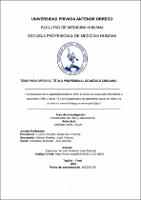| dc.contributor.advisor | Espinoza Llerena, Roberto José Manuel | |
| dc.contributor.author | Mellado Aviles, Josue | |
| dc.creator | Mellado Aviles, Josue | |
| dc.date.accessioned | 2022-05-11T12:53:35Z | |
| dc.date.available | 2022-05-11T12:53:35Z | |
| dc.date.issued | 2022 | |
| dc.identifier.uri | https://hdl.handle.net/20.500.12759/8923 | |
| dc.description.abstract | Determinar la utilidad de las escalas AIR y Lintula en el diagnóstico de
apendicitis aguda y cuál es su correlación con el hallazgo anatomopatológico en
niños del hospital general de jaén entre el 2017-2021
Material y método: Se contó con un tipo de estudio basado en las pruebas
diagnósticas, en donde el diseño estuvo conformado por los siguientes elementos
de evaluación: sensibilidad, especificidad, valor predictivo negativo, valor predictivo
positivo, contando con una muestra de 182 pacientes y habiendo contado con el
instrumento de historias clínicas.
Resultados: Los resultados señalaron que las características de predicción de la
escala AIR han sido los siguientes: sensibilidad en un 38.79%, especificidad en un
88.24%, con una probabilidad de 96.97%para el caso de demostrar una
enfermedad en cuanto a la prueba diagnóstica de demostrar la positividad de la
muestra y se contó con una probabilidad de 12.93% para el caso de no poseer la
enfermedad si el resultado de la prueba diagnóstica llega a ser negativo. Mientras
que, las características de predicción de la escala LINTULA han sido los siguientes:
sensibilidad en un 67.27%, especificidad en un 82.35%, con una probabilidad de
97.37% para el caso de demostrar una enfermedad en cuanto a la prueba
diagnóstica de demostrar la positividad de la muestra y se contó con una
probabilidad de 20.59% para el caso de no poseer la enfermedad si el resultado de
la prueba diagnóstica llega a ser negativo.
Conclusiones: Se concluyó que la escala LINTULA ha demostrado una capacidad
diagnóstica superior a la demostrada por la escala AIR, en cuanto a la respuesta
inflamatoria a apendicitis | es_PE |
| dc.description.abstract | To determine the usefulness of the AIR and lintula scales in the diagnosis
of acute appendicitis and what is its correlation with the pathological finding in
pediatric patients of the General Hospital of Jaén between 2017-2021.
Material and method: There was a type of study based on diagnostic tests, where
the design was made up of the following evaluation elements: positive predictive
value, negative predictive value, sensitivity, specificity, with a sample of 182 patients
and having had the medical record tool.
Results: The results indicated that the prediction characteristics of the AIR scale
have been the following: sensitivity in 38.79%, specificity in 88.24%, with a
probability of 96.97% for the case of demonstrating a disease in terms of the
diagnostic test of demonstrating the disease. positivity of the sample and a
probability of 12.93% was counted for the case of hasn´t the disease if the result of
the diagnostic test becomes negative. While, the prediction characteristics of the
LINTULA scale have been the following: sensitivity in 67.27%, specificity in 82.35%,
with a probability of 97.37% for the case of demonstrating a disease in terms of the
diagnostic test of demonstrating positivity of the sample and a probability of 20.59%
was counted for the case of hasn´t the disease if the result of the diagnostic test
becomes negative.
Conclusions: It was concluded that the LINTULA scale has shown a higher
diagnostic capacity than that shown by the AIR scale, in terms of the inflammatory
response to appendicitis | en_US |
| dc.description.uri | Tesis | es_PE |
| dc.format | application/pdf | es_PE |
| dc.language.iso | spa | es_PE |
| dc.publisher | Universidad Privada Antenor Orrego | es_PE |
| dc.relation.ispartofseries | T_MED_3140 | |
| dc.rights | info:eu-repo/semantics/openAccess | es_PE |
| dc.rights.uri | https://creativecommons.org/licenses/by/4.0/ | es_PE |
| dc.source | Universidad Privada Antenor Orrego | es_PE |
| dc.source | Repositorio Institucional - UPAO | es_PE |
| dc.subject | Escala AIR | es_PE |
| dc.subject | Hallazgo anatomopatológico | es_PE |
| dc.title | Comparación de la capacidad predictiva entre la escala de respuesta inflamatoria a apendicitis (AIR) y lintula (PL) en el diagnóstico de apendicitis aguda en niños y la correlación con el hallazgo anatomopatológico | es_PE |
| dc.type | info:eu-repo/semantics/bachelorThesis | es_PE |
| thesis.degree.level | Título Profesional | es_PE |
| thesis.degree.grantor | Universidad Privada Antenor Orrego. Facultad de Medicina Humana | es_PE |
| thesis.degree.name | Médico Cirujano | es_PE |
| thesis.degree.discipline | Medicina Humana | es_PE |
| dc.subject.ocde | https://purl.org/pe-repo/ocde/ford#3.02.27 | es_PE |
| renati.advisor.orcid | https://orcid.org/0000-0003-2137-8005 | es_PE |
| renati.author.dni | 70483672 | |
| renati.advisor.dni | 41433382 | |
| renati.type | https://purl.org/pe-repo/renati/type#tesis | es_PE |
| renati.level | https://purl.org/pe-repo/renati/level#tituloProfesional | es_PE |
| renati.discipline | 912016 | es_PE |
| renati.juror | Lozano Peralta, Katherine Yolanda | |
| renati.juror | Namoc Medina, Juan Dolores | |
| renati.juror | Caballero Alvarado, José Antonio | |
| dc.publisher.country | PE | es_PE |


